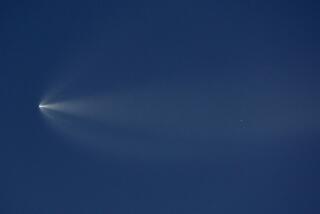Florida Clouds Divert Shuttle to High Desert
- Share via
EDWARDS AIR FORCE BASE — Prevented by low clouds from making a scheduled landing in Florida, the space shuttle Discovery and its five astronauts were diverted to the more hospitable climate of Southern California’s High Desert, touching down at 12:43 p.m. Wednesday.
The astronauts were forced to remain inside Discovery for two hours after landing as a hooded ground crew worked to disperse a toxic gas that leaked from one of the shuttle’s thrusters.
Astronauts usually disembark about 45 minutes after touchdown, when the normal remnants of toxic gas generated during re-entry are dispersed. But on Wednesday the thruster began leaking caustic nitrogen tetroxide minutes before the craft began its one-hour descent. NASA ordered the astronauts to stay aboard to avoid being poisoned by the fumes while engineers wearing protective coveralls and oxygen masks plugged the leak.
Avoiding the rain-soaked dry lake bed that is favored for shuttle landings, Navy Capt. David Walker guided Discovery to a perfect arrival on concrete Runway 22, popping the red, white and blue drag parachute on a crisp afternoon to end NASA’s 52nd shuttle mission, its eighth of 1992 and its last mission to launch a military satellite.
Although shuttle landings are normally viewed by thousands--or tens of thousands--of civilian spectators, Discovery’s landing Wednesday was only seen by scattered clusters of NASA employees. Public viewing areas were closed because of flooding. A busload of schoolchildren on a long-planned tour of Edwards got an unexpected bonus when the shuttle made its arrival during their excursion.
Discovery was waved off from a scheduled 11:16 a.m. landing at the Kennedy Space Center as low clouds started moving in over Cape Canaveral, the sixth time that a shuttle landing had been diverted to Edwards.
Ironically, weather turned out to be good at the Florida runway, according to Kennedy Center Director Robert Crippen. NASA prefers to land the shuttle in Florida because it costs about $1 million to land the shuttle in California and ferry it back to Florida on the back of a specially prepared Boeing 747.
Clouds had proved to be an impediment throughout most of Discovery’s flight, interfering with 18 of 20 attempts to beam laser messages from the ground to the shuttle. Such laser bursts might be used by occupants of downed planes to guide rescuers.
An experiment in which six metal balls meant to simulate “space junk” were to be released and tracked from the ground was also aborted because of the failure of the experiment’s battery pack. Coincidentally, Discovery had to swerve in orbit Tuesday to avoid an unidentified piece of junk, although the shuttle was never in any real danger of colliding with it, officials said.
Discovery did, however, complete its major mission, the launch of a secret military satellite Dec. 3.
The next shuttle mission is tentatively scheduled for launch Jan. 13, when Endeavour will carry a tracking and data relay satellite into orbit. The astronauts will also search for X-rays from hot solar gases and conduct experiments with rats, roots and fire. Two of the astronauts will also conduct a five-hour space walk to hone the skills necessary for repair of the orbiting Hubble Space Telescope late next year.
More to Read
Sign up for Essential California
The most important California stories and recommendations in your inbox every morning.
You may occasionally receive promotional content from the Los Angeles Times.













